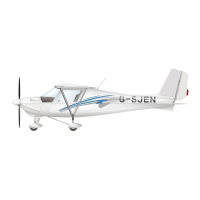
Do you have a question about the iKarus C42 and is the answer not in the manual?
| Manufacturer | Comco Ikarus |
|---|---|
| Type | Ultralight Aircraft |
| Engine | Rotax 912 |
| Cruise Speed | 160 km/h |
| Stall Speed | 65 km/h |
| Seats | 2 |
| Height | 2.3 m |
| Maximum Takeoff Weight | 472.5 kg |
| Range | 800 km |
| Service Ceiling | 4000 m |
| Power Output | 80 hp |
| Rate of Climb | 5 m/s |
Contact information for COMCO IKARUS GmbH and DKL Light Sport Aircraft Sarl.
Contact details for certification data related to COMCO IKARUS and DKL Light Sport Aircraft.
Technical drawings showing the three side views of the IKARUS C42 (C42A) model.
Technical drawings illustrating the three side views of the IKARUS C42B model.
Technical drawings presenting the three side views of the IKARUS C42C model.
Technical drawings detailing the three side views of the IKARUS C42CS model.
Specifies never-exceed, turbulent air, maneuver, and stall speeds for different C42 models.
Details maximum take-off mass, empty weight, and payload specifications.
Outlines admissible positive and negative load factors for the aircraft.
Defines the reference datum and forward/rearward center of gravity positions.
Describes the color-coded arcs and lines on the airspeed indicator.
Specifies maximum and continuous engine RPM limits.
Details the yellow arc and red line markings on the RPM gauge.
Lists the three flap positions and their typical uses (cruising, take-off/landing).
Specifies the maximum allowed speeds for each flap position.
Lists approved propellers and their performance data for ROTAX 912 UL engines.
Lists approved propellers and their performance data for ROTAX 912 ULS engines.
Provides noise levels (dB(A)) for various propellers with ROTAX 912 engines.
Details engine limitations including take-off power, continuous power, oil, fuel, and temperature specifications.
Describes how to maneuver the aircraft on the ground using rudder pedals and nose wheel steering.
Details the procedures for lining up, taking off, and initial climb.
Explains optimal cruise speeds, engine settings, and handling in turbulent weather.
Discusses coordinated turns using ailerons and rudder, and bank angle limitations.
Describes stall speeds for different flap positions and aircraft behavior during stalls.
Outlines procedures for approach, flap usage, and landing speeds.
Instructions for safely shutting down the engine after flight.
Procedures for handling engine power loss during take-off and cruise.
Steps to follow if attempting to restart the engine while airborne.
Information on operating and monitoring the aircraft's cowl flap system.
Step-by-step guidance for various in-flight emergencies and failures.
Instructions and precautions for deploying the aircraft's parachute rescue system.
Explains how to manually move the aircraft on the ground using tail struts and main wheels.
Details how to lift the aircraft using a hoist and designated mounting points.
Provides guidelines for parking the aircraft, including brake and flap settings.
Instructions for securing the aircraft outdoors using ropes and anchors.
Explains how to determine the aircraft's empty weight and center of gravity.
Provides a template for calculating weight and balance based on passenger, fuel, and luggage.
Provides data on take-off distances under various conditions and for different models.
Details climb rates for different engine types and seating configurations.
Lists cruise speeds for single-seated operation based on engine RPM.
Describes aircraft performance characteristics when the engine is shut down.
Step-by-step instructions for attaching the wings to the aircraft fuselage.
Procedures for folding the wings for storage or hangaring.
Checks related to the engine, propeller, cowling, and cooling systems.
Inspection points for the main landing gear, including wheels, brakes, and shock absorbers.
Pre-flight checks for the left wing structure, covering, and control surfaces.
Inspection of the left fuselage fairing, baggage door, and control systems.
Checks for the horizontal stabilizer, elevator, rudder, and trim tab.
Inspection of the right fuselage fairing, baggage hatch, and fuel cap.
Refers to checks for the left wing (14.3) for the right wing.
Checks for windscreen, doors, controls, brakes, and fuel valve.
Verification of power supply, altimeter setting, fuel quantity, and radio functioning.
Instructions for draining fuel tanks.
Details the angles of deflection for ailerons, rudder, elevator, flaps, and trim tab.
Describes additional equipment for handicapped pilots, including modified controls.
Instructions for installing and removing the handicapped control equipment.
Guidance on operating the aircraft with handicapped controls for take-off and landing.
Details the terms and conditions of the aircraft warranty provided by COMCO IKARUS.
Procedure for claiming warranty service and informing the manufacturer of defects.
Requirements for submitting a warranty claim, including necessary documentation.
Conditions that may invalidate the warranty or affect its applicability.
Lists specific conditions and damages not covered by the product warranty.
Identifies the location of various warning and information placards on the aircraft.
Details the information found on the aircraft's data placard, including speeds and limits.
A form for reporting aircraft technical problems and damages.
A log for recording performed inspections and their details.
Shows the installation and securing method of the parachute rescue system.
Provides a schematic diagram of the aircraft's electrical system wiring.
